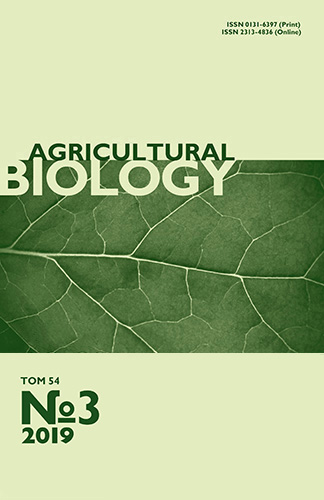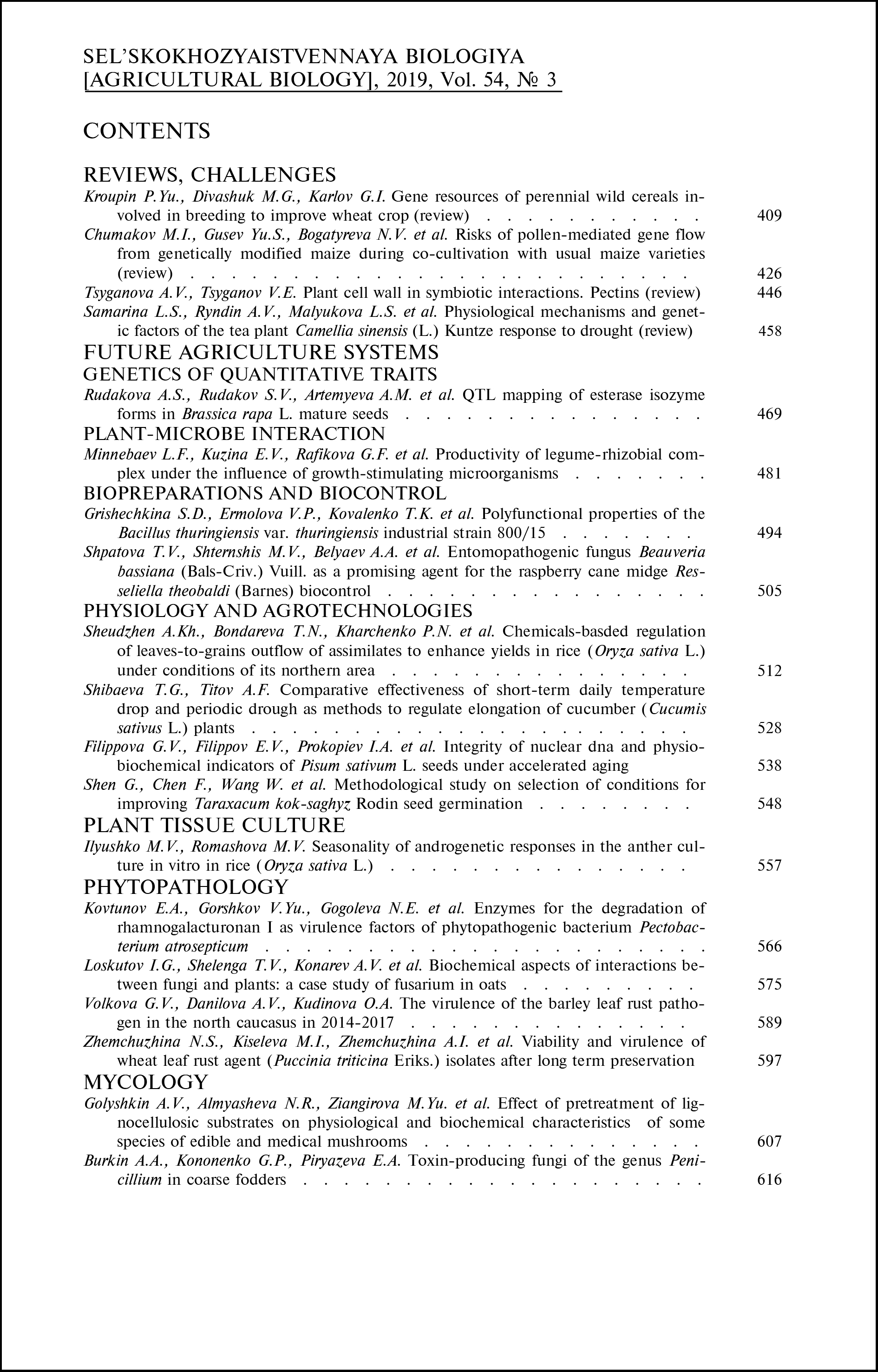doi: 10.15389/agrobiology.2019.3.469eng
UDC: 635.127:577.152.31:577.151.64:577.21
QTL MAPPING OF ESTERASE ISOZYME FORMS IN Brassica rapa L. MATURE SEEDS (review)
A.S. Rudakova1, S.V. Rudakov1, A.M. Artemyeva2, D.A. Fateev2,
N.V. Kocherina3, Yu.V. Chesnokov3
1Moldova State University, Republic of Moldova, MD-2009, Chişinău, Mateevich str., 60, e-mail rud-as@mail.ru, rudacov@yahoo.com;
2Federal Research Center Vavilov All-Russian Institute of Plant Genetic Resources, 42-44, ul. Bol’shaya Morskaya, St. Petersburg, 190000 Russia, e-mail furriongo@gmail.com, akme11@yandex.ru;
3Agrophysical Research Institute, 14, Grazhdanskii prosp., St. Petersburg, 195220 Russia, e-mail alle007@mail.ru, yuv_chesnokov@agrophys.ru (✉ corresponding author)
ORCID:
Rudakova A.S. orcid.org/0000-0001-9638-2151
Fateev D.A. orcid.org/0000-0002-1075-6704
Rudakov S.V. orcid.org/0000-0003-2591-6114
Kocherina N.V. orcid.org/0000-0002-8791-1899
Artemyeva A.M. orcid.org/0000-0002-6551-5203
Chesnokov Yu.V. orcid.org/0000-0002-1134-0292
Received January 22, 2019
Since the 1960s, isoenzymes have been well known as one of the most common biochemical markers. Establishing the overall variability of the isoenzyme systems and identifying their genetic control retain their relevance, allowing researchers to reveal the fine mechanisms of the relationship of the organism with the environment and homeostasis and to develop effective biochemical markers for rapid assessment of genetically and selectively significant material. In this paper, the chromosome loci responsible for the activity of 13 different esterase forms of mature seeds in Brassicarapa L. were identified and mapped for the first time. The doubled haploid lines of two mapping populations, DH30 and DH38, were studied. All identified esterase isoforms were divided into three groups according to their electrophoretic mobility. The group of isoforms A1-A3 had a high molecular weight and low electrophoretic mobility. The group of B1-B7 isoforms exhibited an average molecular weight and an average electrophoretic mobility. The C1-C3 group consisted of isoforms having a low molecular weight and, consequently, the highest electrophoretic mobility. Each of the parental forms, as well as each of the studied lines of mapping populations, had its own unique electrophoretic spectrum of esterase isoforms. Based on the electrophoretic data obtained for both populations, a QTL analysis was carried out and chromosome loci were identified, determining the manifestation of each esterase isoform identified in the mapping lines of populations DH30 and DH38. The composite interval mapping approach, combined with a permutation test (1000 iteration) and a confidence level of p < 0.05, allowed us to identify and locate QTLs on chromosomes that determine the manifestation of all esterase isoforms identified by gel electrophoresis, with the exception of A1 isoform for the DH38 population and B7 isoform for the DH30 population. For these two isoforms, no QTL analysis results were obtained because of limitation in initial data on these isoforms in the corresponding mapping population. A total of 35 QTLs for esterase isoforms were mapped for DH30 mapping population and 39 QTLs for DH38 population. As a result of the QTL analysis, molecular markers genetically linked to the identified loci and the percentage of phenotypic variability determined by each of the identified QTLs were also identified. According to isoenzyme analysis, the heterozygosity of both populations in each Hl locus and total heterozygosity Htotal, as well as Var(Hl)heterozygosity dispersions for one locus and the variance of average heterozygosity within each population Var(Htotal) were calculated. The identified heterozygosity was considered as the average portion of loci with two different alleles in one locus in one individual and could be defined as the observed heterozygosity characterizing the part of the genes for which the studied population is heterozygous. It was shown that in the studied populations of doubled QTL haploid lines, which determine the complex of esterases isoenzymes, are found mainly in the 2nd, 4th, 6th, and 9th linkage groups and form blocks of co-adapted genes and genomic co-adapted gene blocks, which emphasizes the importance of the contribution of these loci in the ontogenesis and adaptability of plants B. rapa. In general, the carried out molecular genetic mapping and biochemical analysis of the studied biochemical traits of various manifestation of esterase isoforms in mature seeds of B. rapa revealed genetic determinants of the studied characters, as well as the genome distribution of mapped QTLs, which in the long term makes it possible to conduct effective molecular and genetic screening of collection accessions and breeding material of the B. rapa species according to these biochemical characters when performing genetic and selection investigations in this species.
Keywords: Brassica rapa L., biochemical analysis, esterase isoforms, mature seeds, QTL mapping, population heterozygosity.
REFERENCES
- Schwartz D., Fuehsman C., McGrath H.K. Allelic isozymes of the pH 7.5 esterases in maize. Genetics, 1965, 52: 1265.
- Solari R.M., Favret E.A. Polymorphism in endosperm proteins of barley and its genetic control. In: Barley genetics II. R. Nilan (ed.). Washington University Press, Pulman WA, 1971: 23-31.
- Artemova N.V. Chromosomal control of the isoenzymes of alcohol dehydrogenase, esterase and amylase in different rye varieties. Genetika, 1982, 18: 661-667.
- Coates P.M., Mestriner M.A., Hopkinson D.A. A preliminary genetic interpretation of the esterase isozymes of human tissues. Ann. Hum. Genet., 1975, 39: 1-20 CrossRef
- Lith H.A., Bieman M., Zutphen B.F.M. Purification and molecular properties of rabbit liver esterase ES-1A. Eur. J. Biochem., 1989, 184: 545-551 CrossRef
- Deimilling O., Wassmer B. Genetic characterization of esterase-28 (ES-28) of the house mouse. Biochem. Genet., 1991, 29: 55-64 CrossRef
- Ivachenko L.E. Uspekhi sovremennogo estestvoznaniya, 2010, 9: 96-98 (in Russ.).
- Chesnokov Yu.V. Molekulyarno-geneticheskie markery i ikh ispol'zovanie v predselektsionnykh issledovaniyakh [Molecular genetic markers and their use in preselection studies]. St. Petersburg, 2013 (in Russ.).
- Walker C.H., Macknees M.I. Esterases: problems of identification and classification. Biochem. Pharmacol., 1983, 32: 3265-3269.
- Pereira A.J., Lapenta A.S., Vidigal-Filho P.S., Machado M.F.P.S. Differential esterase expression in leaves of Manihot esculenta Crantz infected by Xanthomonas axonopodis pv. manihotis. Biochem. Genet., 2001, 39: 289-296 CrossRef
- Carvalho V.M., Marques R.M., Lapenta A.S., Machado M.F. Functional classification of esterases from leaves of Aspidosperma polyneuron M. Arg. (Apocynaceae). Genet. Mol. Biol., 2003, 26(2): 195-198 CrossRef
- MacDonald T., Brewbaker J. Isoenzyme polymorphism in flowering plants. VIII. Genetic control and dimeric nature of transaminase hybrid maize isoenzymes. J. Hered., 1972, 63: 11-14 CrossRef
- Scandalios J.G. Genetic control of multiple molecular forms of enzymes in plants. Biochem. Genet., 1969, 3: 37-79 CrossRef
- Desborough S., Peloquin J. Esterases isozymes from Solanum tubers. Phytochemistry, 1967, 6: 1398-1402 CrossRef
- Cherry J.P., Katterman F.R.H., Endrizzi J.E. Comparative studies of seed proteins of species of Gossypium by gel electrophoresis. Evolution, 1970, 24: 231-447 CrossRef
- Cherry J.P. A comparative study of seed proteins of allopolyploids of Gossypium by gel electrophoresis. Canadian Journal of Genetics and Cytology, 1971, 13: 155-158 CrossRef
- Marshall D.R., Allard R.W. Isozyme polymorphism in natural populations of Avena fatua and A. barbata. Heredity, 1970, 25: 273-282 CrossRef
- Murray B.E., Craig I.L., Rajhathy T. A protein electrophoretic study of three amphidiploids and eight species of Avena. Canadian Journal of Genetics and Cytology, 1970, 12: 651-665 CrossRef
- Lerch B., Wolf G. Isolation of phosphodiesterase from sugar beet leaves. Biochimica et Biophysica Acta (BBA) — Enzymology, 1972, 258: 200-218 CrossRef
- Barber H.N., Driscoll C.J., Vickery R.S. Enzymic markers for wheat and rye chromosomes. In: Proceedings III International Wheat Genetics Symposium. Canberra, 1968: 116-122.
- May C.E., Vickery R.S., Driscoll C.S. Gene control in hexaploid wheat. In: Proceedings 4th International Wheat Genetics Symposium. Columbia, 1973: 843-849.
- Nakai Y. Isozyme variations in Aegilops and Triticum. 2.Esterase and acid phosphatase isozymes studied by the gel isoelectrofocusing method. Seiken Ziho, 1973, 24: 45-73 CrossRef
- Nakai Y. Isozyme variations in Aegilops and Triticum. 3.Chromosomal basis of the esterase isozyme production in different organs of Chinese spring wheat. Bot. Mag. Tokyo, 1976, 89(3): 219-234 CrossRef
- Cubadda R., Bozzini A., Quattrucci E. Genetic control of esterases in common wheat. Theor. Appl. Genet., 1975, 45: 290-293 CrossRef
- Jaaska V. Electrophoretic survey of seedling esterases in wheats in relation to their phylogeny. Theor. Appl. Genet., 1980, 56: 273-284 CrossRef
- Fedak G. Increased homoeologous chromosome pairing in Hordeum vulgare ½ Triticum aestivum hybrids. Nature, 1977, 266: 529-530 CrossRef
- Fejer O., Belea A. Cytology and isoenzymes of some Triticum auto- and amphidiploids. Wheat Information Service, 1978, 47/48: 41-44.
- Alexandrescu N., Saulescu N. Esterase variability in kernels of Triticum aestivum cultivars. Revue roumaine de biochimie, 1982, 19: 93-100.
- Rudakova A.S., Rudakov S.V., Davydova N.V., Mirskaya G.V., Zhuravleva E.V., Chesnokov Yu.V. Isozymic analysis of esterases in mature seeds of hexaploid soft wheat (Triticum aestivum L.). Sel’skokhozyaistvennaya Biologiya [AgriculturalBiology], 2016, 51(3): 327-334 CrossRef
- Rudakova A.S., Rudakov S.V., Artem'eva A.M., Kurina A.B., Kocherina N.V., Chesnokov Yu.V. Izuchenie polimorfizma esteraznogo sostava zrelykh semyan obraztsov redisa (Raphanus sativus L.) kollektsii VIR. Ovoshchi Rossii, 2017, 5: 3-8 CrossRef
- Artem'eva A.M., Solov'eva A.E., Kocherina N.V., Berensen F.A., Rudneva E.N., Chesnokov Yu.V. Fiziologiya rastenii, 2016, 63: 275-289 CrossRef
- Davis B.J. Disc electrophoresis. II. Method and application to human serum proteins. Annals of the NY Academy of Science, 1964, 121: 404-427 CrossRef
- Bradford M.M. A rapid and sensitive method for the quantitation of microgram quantities of protein utilizing the principle of protein dye binding. Analytical Biochemistry, 1976, 72: 248-254 CrossRef
- Meon S. Protein, esterase and peroxidase patterns of phytophtora isolates from Cocoa in Malaysia. Journal of Islamic Academy of Sciences, 1988, 1(2): 154-158.
- Van Ooijen J.W.MapQTL 6. Software for the mapping of quantitative trait loci in experimental populations of diploid species. Wageningen, Netherlands, 2009.
- Kocherina N.V., Artemyeva A.M., Chesnokov Yu.V. Use of LOD-score technology in mapping quantitative trait loci in plants. Russian Agricultural Sciences, 2011, 37: 201-204 CrossRef
- Ronald P.S., Penner G.A., Brown P.D., Brule-Babel A.Identification of RAPD markers for percent hull in oat. Genome, 1997, 40: 873-878 CrossRef
- Voorrips R.E.MapChart: Software for the graphical presentation of linkage maps and QTLs. J. Hered., 2002, 93: 77-78 CrossRef
- Nei M. Estimation of average heterozygosity and genetic distance from a small number of individuals. Genetics, 1978, 89(3): 583-590.
- Lefèvre F., Charrie A. Isozyme diversity within African Manihot germplasm. Euphytica, 1992, 66: 73-80 CrossRef
- Veir B. Analiz geneticheskikh dannykh [Genetic data analysis]. Moscow, 1995: 132-135 (in Russ.).
- Clauss K., Baumert A., Nimtz M., Milkowski C., Strack D. Role of a GDSL lipase-like protein as sinapine esterase in Brassicaceae. Plant J., 2008, 53(5): 802-813 CrossRef
- De Souza A., Hull P.A., Gille S., Pauly M. Identification and functional characterization of the distinct plant pectin esterases PAE8 and PAE9 and their deletion mutants. Planta, 2014, 240(5): 1123-1138 CrossRef
- Biely P. Microbial carbohydrate esterases deacetylating plant polysaccharides. Biotechnol. Adv., 2012, 30(6): 1575-1588 CrossRef
- Gao Z., Qian Q., Liu X., Yan M., Feng Q., Dong G., Liu J. Dwarf 88, a novel putative esterase gene affecting architecture of rice plant. Plant Molecular Biology, 2009, 71(3): 265-276 CrossRef
- Sandukhadze B.I., Zhuravleva E.V., Kochetygov G.V. Ozimaya pshenitsa Nechernozem'ya v reshenii prodovol'stvennoi bezopasnosti Rossiiskoi Federatsii [Winter wheat of Nonchernozem zone in addressing the food security of the Russian Federation]. Moscow, 2011 (in Russ.).
- Casacuberta J.M., Jackson S., Panaud O., Purugganan M., Wendel J. Evolution of plant phenotypes, from genomes to traits. G3: Genes, Genomes, Genetics, 2016, 6(4): 775-778 CrossRef
- Yang W., Guo Z., Huang C., Duan L., Chen G., Jiang N., Fang W., Feng H., Xie W., Lian X., Wang G., Luo Q., Zhang Q., Liu Q., Xiong L. Combining high-throughput phenotyping and genome-wide association studies to reveal natural genetic variation in rice. Nature Communications, 2014, 5: 5087 CrossRef
- Lai C.P., Huang L.M., Chen L.O., Chan M.T., Shaw J.F. Genome-wide analysis of GDSL-type esterases/lipases in Arabidopsis. Plant Mol. Biol., 2017, 95(1-2):181-197 CrossRef
- Rejón J.D., Zienkiewicz A., Rodríguez-García M.I., Castro A.J. Profiling and functional classification of esterases in olive (Olea europaea) pollen during germination. Ann. Bot., 2012, 110(5): 1035-1045 CrossRef












